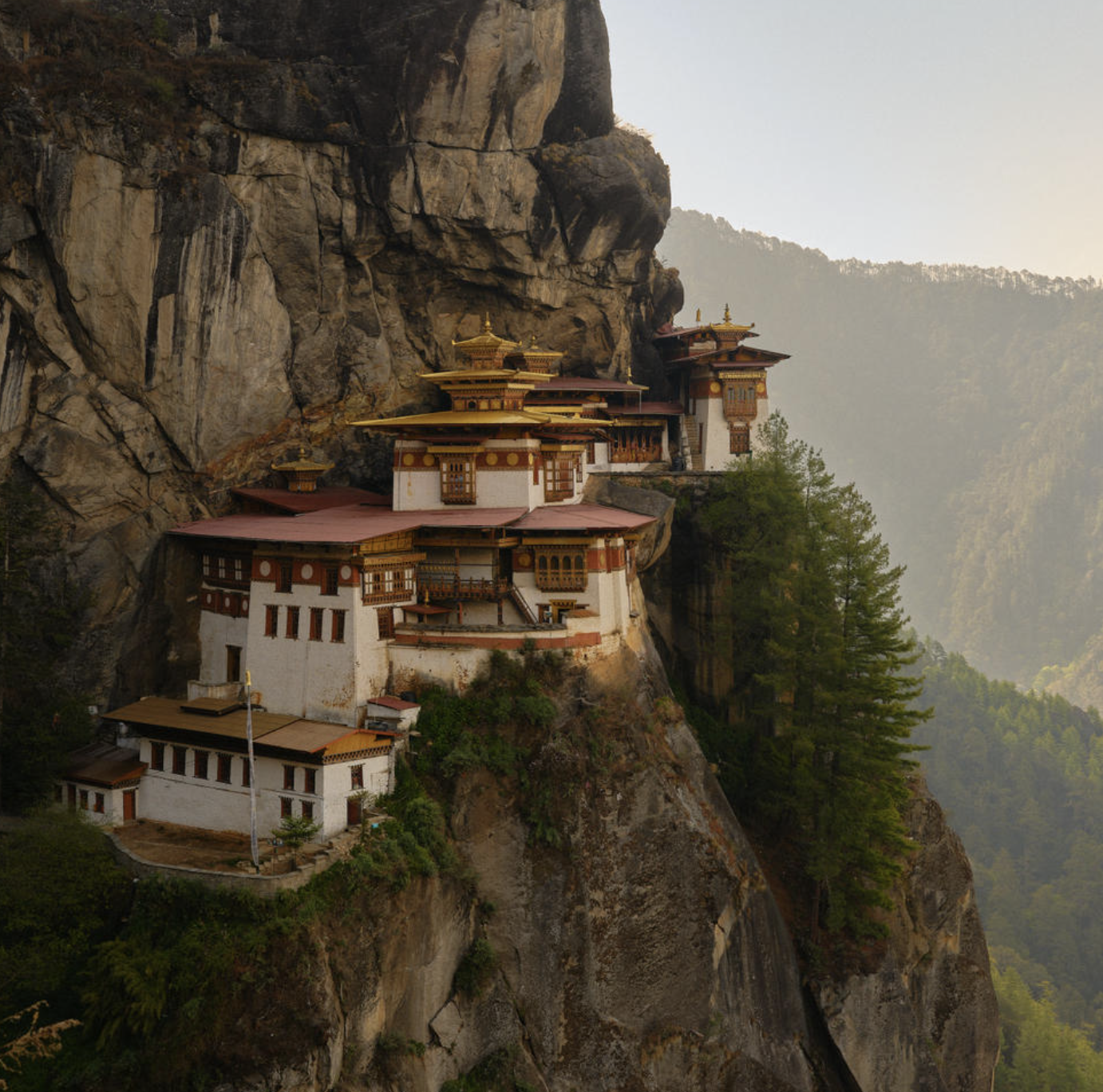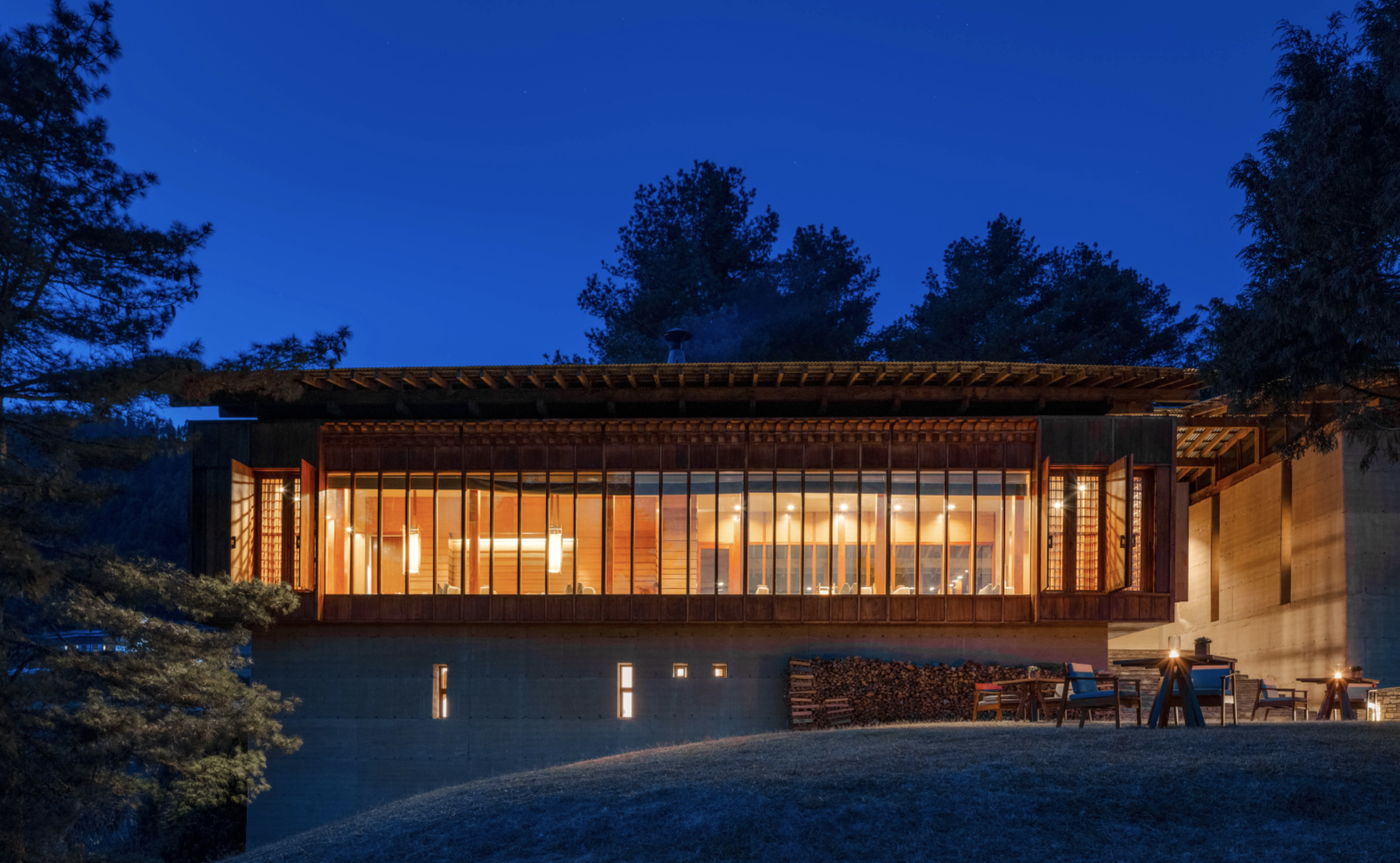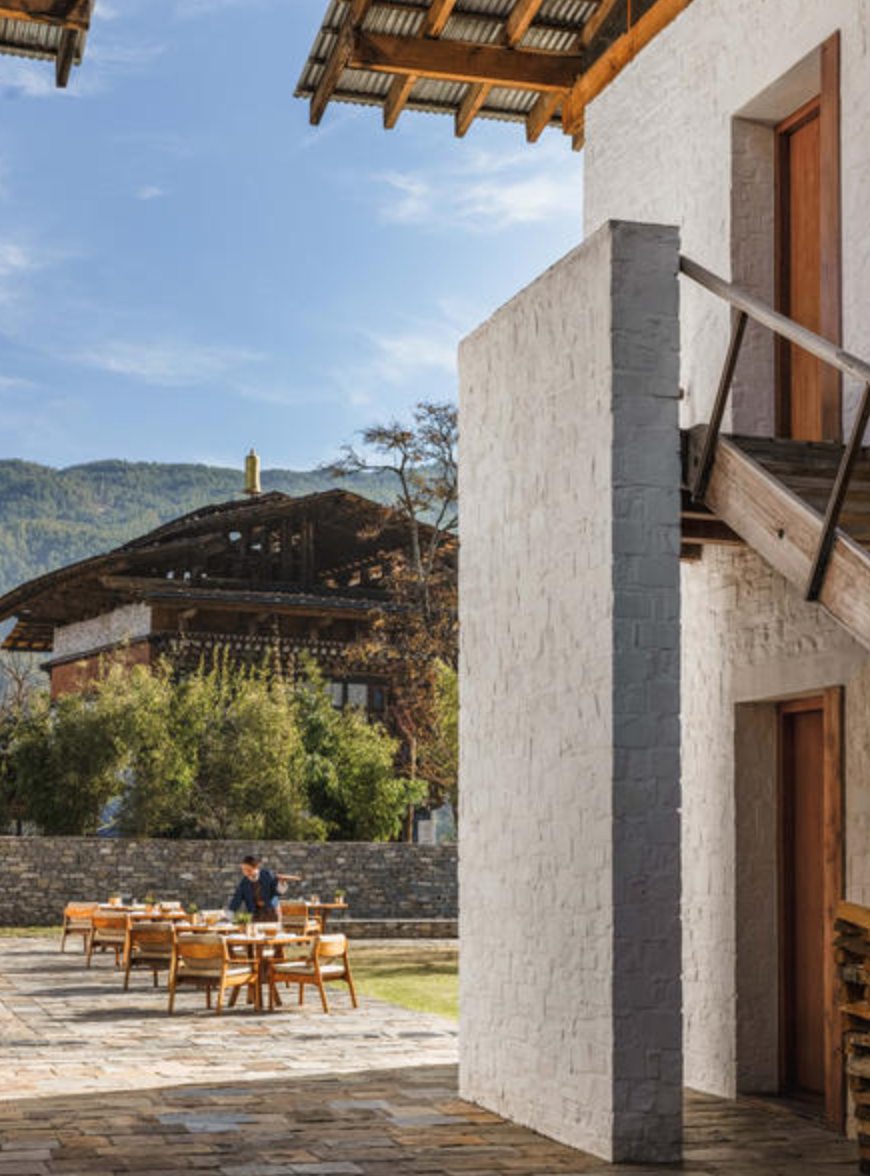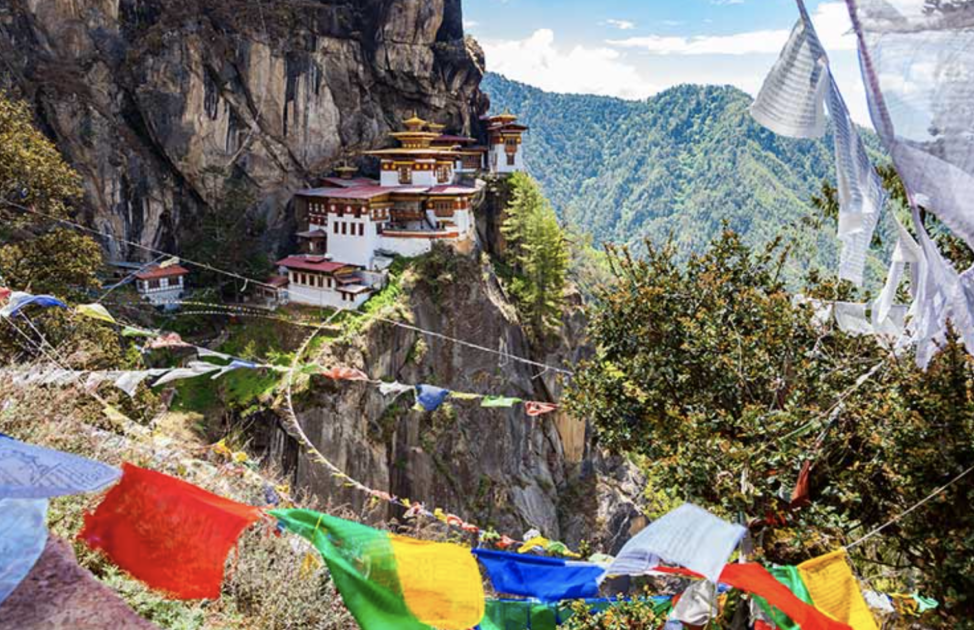I’m slightly out of breath, thanking my Pilates and Soul Cycle instructors for my current level of fitness. The climb has been hard work, but I’m prepared. I’ve had a year to get ready. A year to imagine the moment I’d see this architectural wonder in person. Hanging precariously from a mountain cliff, it’s lived up to the hype. After hiking several miles and over 800 stone steps, I’m face to face with the Tiger’s Nest, an ancient monastery in western Bhutan. I’m in awe.
Bhutan is having a moment. And for good reason. For adventurers looking to explore a part of the world untouched by mainstream tourism—travel to Bhutan. Bhutanese life is filled with festivals, markets, culture, and art. Bhutan hotels offer quiet luxury and authentic food. The Bhutanese people are warm and welcoming. Travel to Bhutan is on the rise. Get on your bike and start peddling—the hike to the Tiger’s Nest is not to be missed.
Is Bhutan on your radar? Are you intrigued yet? Unsure if it’s the right destination for you? Follow along to discover the magic of this faraway kingdom, as well as answers to questions you may have. If they aren’t answered here, just get in touch with the team at CIRE. They’ll know.

Where is Bhutan?
‘So where is this magical country, exactly?’ you might wonder. Bhutan is sandwiched between India and Tibet. Small and landlocked, the kingdom of Bhutan is defined by three topographical features: The Great Himalayas, the Inner Himalayas, and the Southern Foothills. Technically, Bhutan lies at the intersection of South Asia and East Asia. And while Dzongkha (a dialect of Tibetan) is Bhutan’s national language, all kids learn English in school. This makes traveling to Bhutan even more accessible for English-speaking tourists.
Some general facts about Bhutan:
- Bhutan has a population of just under 800,000 people.
- At just over 14,000 square miles, Bhutan is roughly half the size of the state of Indiana.
- Thimphu is the capital of Bhutan.
- Bhutan’s reigning monarch is King Jigme Khesar Namgyel Wangchuck. He’s 43 years old, handsome, and adored by his people.
- Bhutan’s median age is 29.4 years old, with one-third of its population under 14.

How Difficult is it to Travel to Bhutan?
For being such a remote Asian country, getting to Bhutan is not as challenging as one might think. But it’s not as direct as hopping over the pond to London, either. The best way to travel to Bhutan is by air. Cities like Bangkok, Kathmandu, Mumbai, and Dehli offer flights to Paro International, which is Bhutan’s only international airport. Sound daunting? Rest assured, the team at CIRE is on top of flight options and entry requirements so that you can focus on the fun part—hotels, excursions, scenery, and sights.
What is the Best Time of Year to go to Bhutan?
The climate in Bhutan is diverse because of its varied regions. However, the best months to travel to Bhutan are spring and fall. It’s then that tourists will benefit from pleasant, mild temperatures that amplify the glorious terrain. June and July are notoriously hot. In winter months, the weather is quite changeable. In fact, ‘Bhutan’ translates to ‘Land of the Thunder Dragon’ due to the fierce storms that often roll in from the Himalayan mountain range. Unless fierce storms and changeable weather are your thing, spring and fall are your best bets.

Why Travel to Bhutan?
Bhutan has only been open to tourism since 1974, just a few years after it was recognized as a country by the United Nations in 1971. While its history in tourism is short, Bhutan learned how to please travelers quickly.
Some people travel to Bhutan in search of answers, meditative opportunities, and guidance. This tiny Buddhist country has a spiritual footprint that draws travelers from around the world. Monks in Bhutan are accessible and welcome guests with open arms. Others travel to Bhutan with questions, like: ‘Why is the Tiger’s Nest so important?’ or, ‘How did Bhutan become the only carbon-negative country in the world?’
Whether seeking a meditative experience or an adventure-filled one, Bhutan has opportunities for all to enjoy and embrace. Bhutan is one of the most scenic countries in the world, with snow-capped mountains, verdant valleys, and winding rivers. There are opportunities for endless discovery, both personal and atmospheric, in Bhutan.

What to do in Bhutan—an Overview
Travelers to Bhutan could easily spend two weeks without running out of things to do. But should you only have a week or less to spare, a few highlights follow.
Hike to the Tigers Nest (aka Paro Taktsang): Follow a steep and strenuous trail to Bhutan’s most well-known and most photographed landmark. Sitting at 3120 meters above the Paro Valley, the Tiger’s Nest began as a cave used for meditation in the 9th century. In 1692, the monastery was formally built around it. Visitors will pass beautiful scenery along the 3.5-mile in-and-out hike, a powered prayer wheel, and rows of fluttering prayer flags. The Tiger’s Nest itself is an architectural marvel. It’s said to cling to the side of the mountain like a gecko.
Visit Punakha Dzong: Once serving as a stronghold against enemy attack, a dzong is a Bhutanese fortress-monastery. The second largest, second oldest, and arguably the most stunning example is Punakha Dzong. Strategically placed between two rivers, this enormous fortress is even more fascinating once we learn no nails were used to build it. If your itinerary only allows for one dzong visit, this is the one to see.
Grab a bow and arrow: Archery (known in Bhutanese as ‘Da’) became the national sport of Bhutan in 1971. Its popularity has soared with every passing decade since, with tournaments and festivals across the country year-round.
Visitors can participate in, or watch archery at, the Changlimithang Archery Range and Workshops at Changlimithang Stadium in Thimphu. It’s the most popular venue for the sport and is frequented by locals and foreigners alike.

Walk across one of Bhutan’s longest suspension bridges: At 160 meters in length, the Punakha Bridge is one of the longest in Bhutan. It links Punakha Dzong to villages across the Po Chu River. Draped in colorful Bhutanese prayer flags, the bridge is about one-half mile from Punakha Dzong and a wonderful starting point for hikes. In a country defined by high mountains and steep gorges, traversing suspension bridges is a way of life. While they will certainly test anyone’s fear of heights, you’ll likely find them to be surprisingly stable.
Drive the Dochu La Pass: The drive from Punakha to Thimphu will take visitors through a mountain pass in the Himalayas called Dochu La. It’s here where 108 stupas (dome-shaped structures that contain relics and are used for meditation) known as the ‘Druk Wangyal Chortens’ are displayed. At 3100 meters, on a clear day, travelers will have panoramic views of the highest peak in Bhutan—Gangkar Puensum.

Where is Bhutan’s most unique place to stay?
Bhutan has a few wonderful hotels from which travelers can choose to stay. However, Aman Resorts has been a leader in luxury and adventure travel there for decades. Aman is a favorite of discerning travelers who are looking to immerse themselves in the rich culture of the country they’re visiting.
The ‘Amankora Journey’ in Bhutan is based on guest’s individual goals and desires. With five lodges across five valleys and itineraries that range from three days to 16+, Aman’s experiences are unparalleled in Bhutan. The ‘Amankora Journey’ includes things like; all meals, spa treatments, a car, a driver, and a guide. Each lodge is a Himalayan sanctuary unto its own. There’s no better way to get to know the country of Bhutan than with an Aman stay.

Bhutan Travel: Know Before You Go
Bhutan is a safe country to visit. Petty crime is uncommon and violent crime is extremely rare. As in any foreign country, however, it’s always important to be alert. Visitors from the US will need to obtain a visa. It’s important to note that Bhutan charges visitors a daily tariff of up to $250 a day in the high season.
Other things to know before traveling to Bhutan follow:
- Bhutanese food tends to be spicy. Be warned!
- When visiting a dzong, jeans and hats aren’t allowed. Be respectful by covering up your arms and legs.
- Internet service is spotty in Bhutan. Consider getting a SIM card when entering the country.
- Bhutan roads are windy and steep. If you’re prone to car sickness, don’t forget to pack medications.
- Travel insurance is mandatory when visiting Bhutan.
You’re Going Where?
Bhutan is as far off the beaten path as one can get these days. It’s a country known for its staggering beauty, welcoming people, and rich cultural history. Overall, Bhutan is a must-visit for intrepid travelers. The team at CIRE is familiar with all tourist requirements and has a strong relationship with Aman Resorts as well as other Bhutan hotels.
So, when you tell your friends you’re going to Bhutan and they say, “Where is Bhutan?” you’ll know. Ready to tackle the Tiger’s Nest? Dust off those hiking boots and start preparing.
(All photos courtesy of Aman Resorts)

Jamie Edwards is an avid traveler, travel writer, and photographer. She launched I am Lost and Found, her adventure/luxury travel website after 25 years of living and traveling around the globe. Jamie’s goal is simple, to inspire travel.
CIRE Travel is a full-service travel agency headquartered in New York, NY. Our expert corporate travel planners, honeymoon travel agents, and luxury travel planners support clients across the country and around the world.
Where in the World Do You Want to Go?
Inspired to plan your next weekend getaway, vacation or trip of a lifetime? See that form below? That’s all it takes to begin your next epic travel story.


